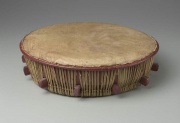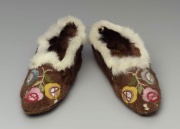Difference between revisions of "Animal skin"
| (2 intermediate revisions by the same user not shown) | |||
| Line 2: | Line 2: | ||
== Description == | == Description == | ||
| − | The raw or dressed skin of a small animal such as a pig, [[goat|goat]], sheep, or calf. A freshly slaughtered skin contains about 65% water and 33% protein (Kuhn 1986). Small amounts of other materials, such as fats, carbohydrates, and minerals, are also present. Tanning chemically changes the skin and makes it resistant to putrefaction. | + | The raw or dressed skin of a small animal such as a pig, [[goat|goat]], sheep, or calf. A freshly slaughtered skin contains about 65% water and 33% protein (Kuhn 1986). Small amounts of other materials, such as fats, carbohydrates, and minerals, are also present. Tanning chemically changes the skin and makes it resistant to putrefaction (see [[leather]] and [[parchment]]). |
| − | See also [[buckskin|buckskin]], [[calfskin|calfskin]], [[capeskin|capeskin]], [[deerskin|deerskin]], [[doeskin%20leather|doeskin]], [[fish%20skin|fish skin]], [[goatskin|goatskin]], [[hide|hide]], [[kangaroo%20skin|kangaroo skin]], [[kidskin|kidskin]], [[lambskin|lambskin]], [[lizard%20skin|lizard skin]], [[moleskin|moleskin]], [[pigskin|pigskin]], [[salmon%20skin|salmon skin]], [[sealskin|sealskin]], [[sharkskin|sharkskin]], and [[snakeskin|snakeskin]]. | + | See also [[buckskin|buckskin]], [[calfskin|calfskin]], [[capeskin|capeskin]], [[deerskin|deerskin]], [[doeskin%20leather|doeskin]], [[fish%20skin|fish skin]], [[goatskin|goatskin]], [[hide|hide]], [[kangaroo%20skin|kangaroo skin]], [[kidskin|kidskin]], [[lambskin|lambskin]], [[lizard%20skin|lizard skin]], [[moleskin|moleskin]], [[pigskin|pigskin]], [[salmon%20skin|salmon skin]], [[sealskin|sealskin]], [[sharkskin|sharkskin]], [[sheepskin]], and [[snakeskin|snakeskin]]. |
| + | For more information on animal skin structure, leather preparation, skin identification, and leather deterioration, please see: AIC Wikis for the Book and Paper Group: [https://www.conservation-wiki.com/wiki/BPG_Animal_Skin_and_Leather Animal Skin and Leather] and the Objects Group [https://www.conservation-wiki.com/wiki/Leather_and_Skin Leather and Skin] | ||
[[File:97.157-SC16174.jpg|thumb|Womens shoes<br>MFA# 97.157]] | [[File:97.157-SC16174.jpg|thumb|Womens shoes<br>MFA# 97.157]] | ||
Latest revision as of 13:17, 5 October 2024
Description
The raw or dressed skin of a small animal such as a pig, Goat, sheep, or calf. A freshly slaughtered skin contains about 65% water and 33% protein (Kuhn 1986). Small amounts of other materials, such as fats, carbohydrates, and minerals, are also present. Tanning chemically changes the skin and makes it resistant to putrefaction (see Leather and Parchment).
See also Buckskin, Calfskin, Capeskin, Deerskin, doeskin, Fish skin, Goatskin, Hide, Kangaroo skin, Kidskin, Lambskin, Lizard skin, Moleskin, Pigskin, Salmon skin, Sealskin, Sharkskin, Sheepskin, and Snakeskin.
For more information on animal skin structure, leather preparation, skin identification, and leather deterioration, please see: AIC Wikis for the Book and Paper Group: Animal Skin and Leather and the Objects Group Leather and Skin
Synonyms and Related Terms
skin; hide; piel (Esp.); cuero animal (Esp.); pele animal (Port.); huid van een dier of dierenhuid (Ned);
Resources and Citations
- Hermann Kuhn, Conservation and Restoration of Works of Art and Antiquities, Butterworths, London, 1986

